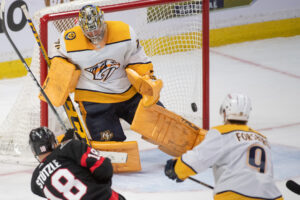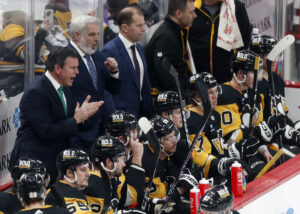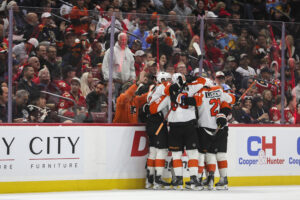The Tampa Bay Lightning went zero for five against the Edmonton Oilers on the power play. Additionally, they allowed a short-handed goal on top of that. Losing the game 3-2, by one goal, makes that fact an even more difficult pill to swallow. What happened in this game that made this power play so unsuccessful?
Tampa Bay Lightning Powerplay Struggles Against Oilers
The Tampa Bay Lightning Powerplay Needs A Reset
The Tampa Bay Lightning power play has not been terrible on the surface of things. It is something that has already been touched on before here at Last Word. They are ranked 16th in the league with a 22.2% power play success rate. That’s taking into account them being four for 22 in their last five games. But regardless of that, it’s the same old story every time they struggle. This writer decided to track the Edmonton game and all the micro stats that could have been tracked.
Passing Themselves Into Submission
The Lightning’s top unit is as follows: Steven Stamkos, Brayden Point, Vladislav Namestnikov, Nikita Kucherov, and Victor Hedman. Together, they combined for 33 pass attempts and eight shots while on the man advantage (that counts 6v5 in the final two minutes of regulation.) 33 passes and eight shots, therein lies the problem. Of those 33 passes, they completed 30 of them, with Kucherov having three of his passes intercepted. There were also misfired passes/shots (shots or passes that were off the mark or blocked but did not lead to turnovers) on nine of their 54 total touches. Additionally, there were four giveaways (players knocked off possession cleanly). So, of their 54 total touches, 13 of them turned into turnovers, and only eight led to shots on goal for the top unit. That is not a recipe for success.
The second unit is as follows: Alex Killorn, Brandon Hagel, Ross Colton, Corey Perry, and Mikhail Sergachev. They combined for 32 pass attempts, six misfires, two interceptions, two giveaways and one single shot on goal. 32 pass attempts, two of them interceptions, and just one shot on goal. That is considerably worse than the first unit, which is to be expected but is disappointing considering the fact the first unit has not been generating enough. What’s worse is that Perry had the lone shot for the team, and he is the net-front guy. Colton is the usual shooter on that line; he had no shots and just five total touches (five passes and one interception). Just not good enough.
Deeper Numbers On The Tampa Bay Lightning Powerplay
Additionally, the Lightning simply could not generate entries against the Oilers at all. In fact, the power play had almost as many clean exits (10) as they did entries (11). With entries, they had 11 with control, seven fails, and two dump-ins. That’s a 55.6% success rate on entries against the Oilers. In all five games that this writer has tracked, counting this one, they gained the offensive zone with control on 60.9% of their attempts. They also fail, on average 4.4 times per game. They failed at a higher clip than their five-game sample average.
Overall Outlook
After the Oilers game, the problems for the Tampa Bay Lightning powerplay continued to mount. The predictability of their entries and the lack of shooting brings this team down in a big way. It’s just obvious at this point. The defender, usually Hedman, drops the puck back to either Kucherov or Namestnikov in the neutral zone, and then they pass it to Point as he skates up ice. All their opponents have to do is find Point, read his skating lane, and take it away. It worked for Edmonton.
Then once they are in the zone, they play tight to Kucherov and try to take away the cross-ice pass to Stamkos, and force him to play it up to Hedman. Hedman has not been shooting (just two total shots in the games tracked) so they are not afraid of his presence. Or, they pressure Kucherov and take away the shooting lane, and then read his eyes and pick off his pass back to Hedman. Like clockwork.
The puck rarely gets to the net, rarely gets down low, and the passing sticks between three players: Kucherov, Hedman, and Stamkos. It isn’t working. Hedman needs to take more shots, presenting more of a threat at the point. Kucherov needs to stop making the same passes over and over again and try to work the puck toward Point as he has done so successfully in the past. Until then, this power play looks like a shell of itself, and that’s putting it very nicely.
All stats tracked by Kyle Pereira, inspired by Cam Charron of The Athletic.
Main Photo:






